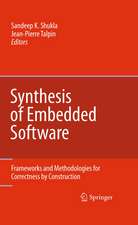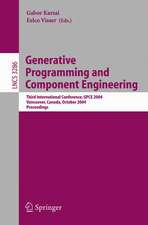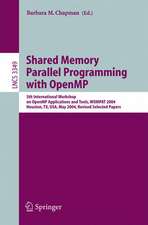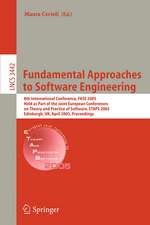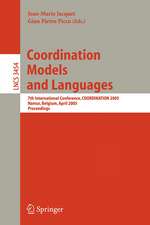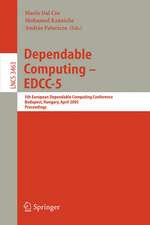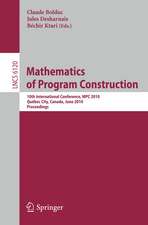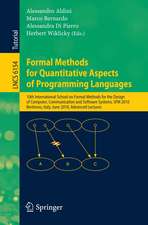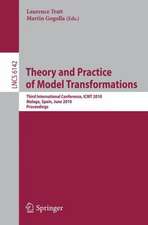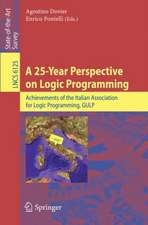Cyber-Physical System Design from an Architecture Analysis Viewpoint: Communications of NII Shonan Meetings
Editat de Shin Nakajima, Jean-Pierre Talpin, Masumi Toyoshima, Huafeng Yuen Limba Engleză Paperback – 9 dec 2018
The book is concerned with internationally standardized modeling languages such as AADL, SysML, and MARTE. As the effectiveness of the technologies is demonstrated with industrial sample cases from the automotive and aerospace sectors, links between the methods presented and industrial problems are clearly understandable. Each chapter is self-contained, addressing specific scientific or engineering problems, and identifying further issues. In closing, it includes perspectives on future directions in CPS design from an architecture analysis viewpoint.
| Toate formatele și edițiile | Preț | Express |
|---|---|---|
| Paperback (1) | 639.52 lei 6-8 săpt. | |
| Springer Nature Singapore – 9 dec 2018 | 639.52 lei 6-8 săpt. | |
| Hardback (1) | 645.79 lei 6-8 săpt. | |
| Springer Nature Singapore – 18 mai 2017 | 645.79 lei 6-8 săpt. |
Preț: 639.52 lei
Preț vechi: 799.41 lei
-20% Nou
Puncte Express: 959
Preț estimativ în valută:
122.41€ • 133.01$ • 102.89£
122.41€ • 133.01$ • 102.89£
Carte tipărită la comandă
Livrare economică 21 aprilie-05 mai
Preluare comenzi: 021 569.72.76
Specificații
ISBN-13: 9789811351365
ISBN-10: 9811351368
Ilustrații: XIV, 159 p. 52 illus., 32 illus. in color.
Dimensiuni: 155 x 235 mm
Greutate: 0.25 kg
Ediția:Softcover reprint of the original 1st ed. 2017
Editura: Springer Nature Singapore
Colecția Springer
Locul publicării:Singapore, Singapore
ISBN-10: 9811351368
Ilustrații: XIV, 159 p. 52 illus., 32 illus. in color.
Dimensiuni: 155 x 235 mm
Greutate: 0.25 kg
Ediția:Softcover reprint of the original 1st ed. 2017
Editura: Springer Nature Singapore
Colecția Springer
Locul publicării:Singapore, Singapore
Cuprins
1 Virtual Prototyping of Embedded Systems: Speed and Accuracy Tradeoffs.- 2 Model-Based Design And Automated Validation Of ARINC653 Architectures using the AADL.- 3 Formal Semantics of Behavior Specifications in the Architecture Analysis and Design Language Standard.- 4 MARTE for CPS and CPSoS.- 5 Combined Model Checking and Testing Create Confidence – A Case on Commercial Automotive Operating System.- 6 Formal Methods for Aerospace Systems.
Notă biografică
Editors:
Shin Nakajima is a professor at the National Institute of Informatics (NII) and also a professor at the Graduate University for Advanced Studies (SOKENDAI). His research interests include formal methods, automated verification, and software testing.
Jean-Pierre Talpin is a senior research associate (directeur de recherche) with Inria and leads Inria project-team TEA (time, events and architectures). His research background ranges from type theory, programming languages, concurrency theory, code generation, scheduling, and verification to proof. His current research interests include the component-based design, analysis, verification, and integration of cyber-physical systems.
Masumi Toyoshima is a research project manager at DENSO Corporation. His research background includes design of distributed computing systems and recent interest is Systems Engineering. Huafeng Yu is a senior researcher with Boeing Research & Technology. He serves onIEEE Technical Committee on for Cyber-Physical Systems. His research interests include mobile autonomous systems, software architecture and safety, model-based engineering, and software certification.
Shin Nakajima is a professor at the National Institute of Informatics (NII) and also a professor at the Graduate University for Advanced Studies (SOKENDAI). His research interests include formal methods, automated verification, and software testing.
Jean-Pierre Talpin is a senior research associate (directeur de recherche) with Inria and leads Inria project-team TEA (time, events and architectures). His research background ranges from type theory, programming languages, concurrency theory, code generation, scheduling, and verification to proof. His current research interests include the component-based design, analysis, verification, and integration of cyber-physical systems.
Masumi Toyoshima is a research project manager at DENSO Corporation. His research background includes design of distributed computing systems and recent interest is Systems Engineering. Huafeng Yu is a senior researcher with Boeing Research & Technology. He serves onIEEE Technical Committee on for Cyber-Physical Systems. His research interests include mobile autonomous systems, software architecture and safety, model-based engineering, and software certification.
Textul de pe ultima copertă
Providing a wide variety of technologies for ensuring the safety and dependability of cyber-physical systems (CPS), this book offers a comprehensive introduction to the architecture-centric modeling, analysis, and verification of CPS. In particular, it focuses on model driven engineering methods including architecture description languages, virtual prototyping, and formal analysis methods.
CPS are based on a new design paradigm intended to enable emerging software-intensive systems. Embedded computers and networks monitor and control the physical processes, usually with the help of feedback loops where physical processes affect computations and vice versa. The principal challenges in system design lie in this constant interaction of software, hardware and physics. Developing reliable CPS has become a critical issue for the industry and society, because many applications such as transportation, power distribution, medical equipment and tele-medicine are dependent on CPS. Safety and security requirements must be ensured by means of powerful validation tools. Satisfying such requirements, including quality of service, implies having formally proven the required properties of the system before it is deployed.
The book is concerned with internationally standardized modeling languages such as AADL, SysML, and MARTE. As the effectiveness of the technologies is demonstrated with industrial sample cases from the automotive and aerospace sectors, links between the methods presented and industrial problems are clearly understandable. Each chapter is self-contained, addressing specific scientific or engineering problems, and identifying further issues. In closing, it includes perspectives on future directions in CPS design from an architecture analysis viewpoint.
The book is concerned with internationally standardized modeling languages such as AADL, SysML, and MARTE. As the effectiveness of the technologies is demonstrated with industrial sample cases from the automotive and aerospace sectors, links between the methods presented and industrial problems are clearly understandable. Each chapter is self-contained, addressing specific scientific or engineering problems, and identifying further issues. In closing, it includes perspectives on future directions in CPS design from an architecture analysis viewpoint.
Caracteristici
Provides practitioners and researchers with a comprehensive introduction to the architecture-centric modeling, analysis, and verification of cyber-physical systems (CPS) Demonstrates the effectiveness of the technologies with industrial sample cases from the automotive and aerospace sectors Consists of self-contained chapters addressing specific scientific or engineering problems, and identifying further issues Includes supplementary material: sn.pub/extras



